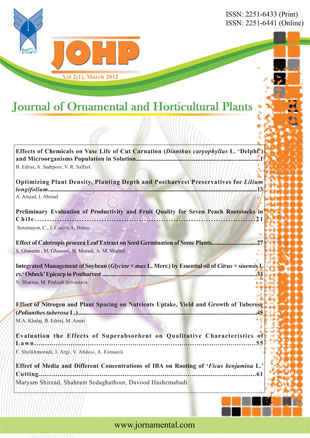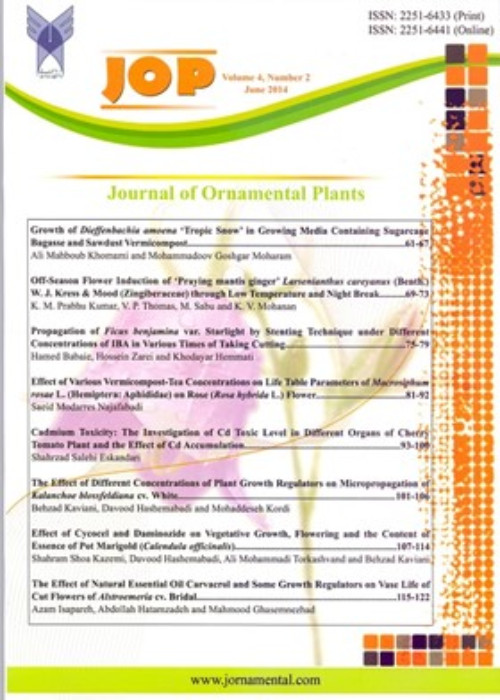فهرست مطالب

Journal of Ornamental Plants
Volume:2 Issue: 1, Winter 2012
- تاریخ انتشار: 1391/02/27
- تعداد عناوین: 8
-
Page 1The vase life of cut flowers and foliage is often shortened by vascular occlusions that constrict vase solution supply. Reduction in stem conductivity is typically caused by blockage of cut stem ends and xylem conduits by microbes, physiological plugging, and disruption of water columns in xylem vessels by cavitations and air emboli. Cut flower and foliage longevity can be greatly affected by the chemical composition of the vase solution. A broad range of biocides has been suggested to prevent the proliferation of microorganisms in vase solutions; however, their assumed antimicrobial action may be confounded by their other physicochemical effects. the effect of some chemicals on postharvest longevity and microorganisms in solution of cut carnation ‘Delphi’ evaluated in a randomized complete block design with three replications. Flowers harvested in paint brush stage and recutted to 60 cm stem length. Vase life evaluated in 20±2 oC temperature, relative humidity 60% and 1800 lux light intensity. The results showed that flowers longevity has significant different (P ≤0.01) and copper sulfate and Halamid® (Sodium N-Chloro-para- Toluenesulfonamide) were the best treatments. Population (P≤0.001) and relative water content (P≤0.05) were significantly affected by treatments and Halamid® was the best treatment to microorganisms control and water content. Highly significant negative correlation of relative water content and the bacterial population in solution indicate that the main effect of bacteria in reducing the water uptake.
-
Page 13A study was conducted to standardize production and postharvest handling of lily (Lilium longifolium L. cv. Mero Star). In production trial, three plant densities viz. 10, 20 and 30 cm between plants in 60 cm spaced rows and two planting depths viz. 7.5 and 15 cm were compared. Increased plant growth, yield and quality was recorded when plants were grown at a close spacing of 10 cm with 15 cm planting depth. In postharvest experiment, holding preservative solutions revealed significant superiority of cobalt chloride @ 5 × 10-4 M with longer vase life (9.0 Days), higher relative fresh weight (98.0%) and higher vase solution uptake rate (0.25 g g-1 IFW). However, for pulsing solutions, longer vase life (8.0 days) and higher relative fresh weight (93.0%) was recorded with 500 mg L-1 8-hydroquinoline sulphate (8-HQS) while higher vase solution uptake rate (0.28 g g-1 IFW) for 200 mg L-1 8-HQS. For lilium production, higher plant density with deeper bulb planting proved better and pulsing with 8-HQS followed by placement in cobalt chloride solution improved postharvest performance and extended longevity rather than sucrose. Moreover, lilium did not like sucrose during postharvest handing. These results would help growers and stakeholders to increase lilium yield and improve flower quality and longevity.
-
Page 21Fruit productivity and quality of eight years peach and nectarine cultivars (Rich Lady, Ryan Sun, Ruby Diamond and Venus) grafted onto Cadaman-Avimag, Viking, Atlas, GxN 15, GF 677, MRS 2/5 and Nemaguard (control) rootstocks were evaluated. A Split Plot experimental design was used, with each rootstock/scion combination as an experimental unit. Total yield, fruit size distribution, number of fruit, and fruit weight were recorded. Fruit quality parameters including soluble solids concentration (SSC), blush color development, and flesh firmness were also measured. On average, Cadaman yielded the greatest fruit weight and number of fruit, compared with the control, followed by GxN 15, Atlas and GF 677 to a lesser degree, while Viking was similar to the Nemaguard control, and MRS 2/5 yielded less than the control. There were no great differences between the rootstocks and the control with respect to fruit size and weight, although the most vigorous, Cadaman and GxN 15, were significantly higher (190.1 and 197.2 g, versus 179.5, respectively). For fruit quality parameters, Viking had the highest accumulation of SSC with respect to Nemaguard and MRS 2/5 had the highest percentage of blush color compared with the control. For flesh firmness at harvest, GF 677 was the firmest and MRS 2/5 was the softest.
-
Page 27Calotropis procera (Asclepidaceae) is an evergreen plant and widely distributed in Hormozgan province. This plant has the allelopathic properties including germination inhibition, plumule and radicle growth reduction. In this study the effect of different concentrations (0, 5, 10, 20, 40 and 60%) of dry leaf water extraction of this plant on the germination of cucumber (Cucumis sativus), tomato (Lycopersicon esculenthum), and eggplant (Solanum melongena) were investigated. The results showed that water extract significantly decreased the germination percentage especially at high concentrations. The radicle and plumule length also were affected by the extract concentrations.
-
Page 33The essential oil extracted from the epicarp of Citrus sinensis exhibited absolute fungitoxicity against soybean‘s fungus as Alternaria alternate, Aspergillus niger, Cercospora kikuchii, Chaetomium spp., Cladosporium cladosporioides, Curvularia lunata, Fusarium roseum, Macrophomina phaseolina, Penicillium italicum, Phomopsis spp. Rhizoctonia solani, and Sclerotium rolfsii. It is very difficult to manage these pathogens by their nature of survival in seed. GC-MS studies of the oil revealed the presence of 10 chemical constituents of them limonene was found to be the major component (84.2 %). The activity of the oil was tested by the poisoned food technique and volatile activity assay. It was found that volatile activity was more toxic than poisoned food technique. The oil was extremely toxic for spore germination and it was found that at 700 ppm spore germination was inhibited in the ten test fungi out of the twelve tested. The essential oil demonstrated wide spectrum fungitoxicty. The seed were treated with essential oil for different concentration. It is evident that the treatment of essential oil inhibited the growth of dominant fungi. In 600 ppm Fusarium roseum, Penicilluim italicum, Rhizocotonia solani and Sclerotium rolfsii were inhibited but in 700 ppm all tested fungi who is found in untreated seed were inhibited. The scanning electron microscopy (SEM) was done to study the mode of action of oil in case of Aspergillus niger and it was observed that the treatment of oil leads to the distortion and thinning of hyphal wall and the reduction in hyphal diameter and absence of conidiophores.
-
Page 45Plant spacing and nitrogen are the most important factors for increasing tuberose quality and quantity. In this study, field experiment carried out as factorial Randomized Completely Block Design (RCBD) in 3 replications. Different levels of nitrogen (0, 50, 100, 150, 200, 250 kg/ha) of ammonium nitrate was used. Second factor was different plant spaces (10, 15, 20 and 25 cm). Results showed that the 25 cm plant space had a significant effect on flower stalk height, stem diameter, spike length, floret diameter, floret weight, vase life and nutrient uptake. Nitrogen levels affected on stem diameter, spike length and nitrogen uptake. The results show that using 200 kg/ha N can improves growth and yield of tuberose as flower stalk height, stem diameter and bulb weight. Data showed that the maximum quality and quantity of flower obtained in 25 cm plant spacing plus 200 kg/ha N.
-
Page 55Water sources optimizing required a suitable irrigation program. Different material can use to increase water use efficiency. Superabsorbent is one of the materials where used in around the world. These materials put in the soil and absorb water so that reserved water is usable by plant in the time of drought stress and they can reduce stress and lead to prevent yield loss. Therefore, the experiment was conducted to evaluate effects of different superabsorbent and irrigation cycles on lawn. A split plot experiment based on randomized block design with three replications was used. Irrigation cycles and superabsorbent amounts used as main-plot and sub-plots respectively. Four irrigation periods (1, 2, 4 and 6 days) and four superabsorbent amounts (0, 20, 25 and 30 g/m2) were used as experimental treatments. One-day irrigation interval and zero superabsorbent amounts were used as control. Lawn water requirement was calculate by evaporation from a pan class. Results showed that superabsorbent amount had significant effect on shoot height, total chlorophyll and plant density. Results showed that lawn performance was higher in 30 g/m2 of superabsorbent amount at two-day irrigation cycle.
-
Page 61Ficus benjamina is a very popular and resistant indoor plant intemperate areas. Cutting is the easiest propagation method of this plant and it requires special treatments such as auxin and appropriate rooting medium. In order to test the suitable auxin (IBA) concentration and rooting media, a factorial experiment carried out based on randomized complete block design with three replications. Experimental two factors were different concentrations of IBA (0, 2000, 4000 and 6000 ppm) and rooting media (sand, perlite and sand + perlite mixture). Rooting percentage, root number and longest root length was evaluated. Based on the results both rooting percent and longest root length were gained under 4000 ppm IBA. Rooting percent was maximized in combined treatment of "4000 ppm IBA + perlite" and "6000 ppm IBA + sand". The high number of roots was gained in "6000 ppm IBA+ sand".


